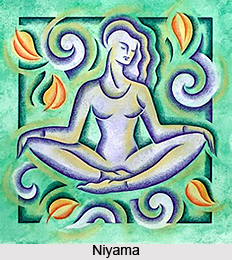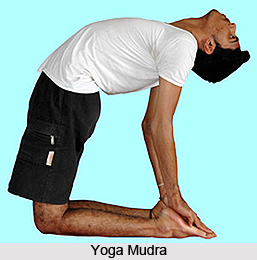 Niyamas are the positive actions in Ashtanga Yoga that aim at self-discipline and development. Niyama is observance of five canons to build a proper individual personality from within. Unlike Yama, Niyama prescribes mental exercises to train the mind in order to control human emotions.
Niyamas are the positive actions in Ashtanga Yoga that aim at self-discipline and development. Niyama is observance of five canons to build a proper individual personality from within. Unlike Yama, Niyama prescribes mental exercises to train the mind in order to control human emotions.
The concept of Niyama is mentioned in numerous scriptures; including the Shandilya and Varuha Upanishads, Hatha Yoga Pradipika by Gorakshanatha, the Tirumantiram of Tirumular and the Yoga Sutras of Patanjali. All the above texts enlist ten Niyamas, with the exception of Patanjali`s work, which lists only five. Patanjali states the "shall-do" in the regular dealings with the inner world; Swami Vivekananda describes them as the second step of Raja yoga. The five Niyamas according to Patanjali include Shaucha (internal and external purity), Samtosha (contentment), Tapas (austerity), Svadhyaya (study of religious books and repetitions of Mantras), and Ishvarapranidhana (self-surrender to God, and His worship).
Shaucha (Purification) Niyama indicates cleanliness of both the external body and the internal mind. Cleanliness of the body is brought about by the use of earth, water and disinfectants. Cleanliness of mind is brought about by the removal of mental impurities like pride, vanity, jealousy, anger and so on. External cleanliness indicates disinclination to one`s body and cessation of contact with others. This enables the citta to attain purity and one acquires high-mindedness, one-pointedness, control of senses and fitness for the knowledge of the self. Shaucha can be achieved by routine pattern of cleaning one`s body parts and keeping them in healthy conditions; by consuming nutritious and vegetarian diet and making the internal environment pure; by cleansing internal organs by neti, basti, dhauti and so on; and by cleansing the body by Ayurvedic techniques of Pancha Karma. Purity of Mind can be gained through healthy thoughts and emotions; by cleansing one`s mind of unwanted thoughts, feelings and emotions through `catharsis` and by chanting mantras and prayers regularly to cleanse the thought process.
Samtosha (Contentment) Niyama reflects the idea of the absence of desire to acquire more than what is necessary for the preservation of one`s life. Since the sadhaka aims at attaining a condition in which he remains perfectly calm and serene, irrespective of whatever may happen in the outer world, he should live in mental comfort and contentment. This kind of composure can be gained on the establishment of perfect contentment. This is a positive mental attitude and is based on a perfect indifference to the personal enjoyments, comforts and so on. For attaining Samtosha, a constant alertness and a training of the mind, in maintaining the right attitude, is necessary. Santosha brings about a state of cheerfulness and benevolence. Patanjali Yoga sutra teaches that instead of grieving or complaining about the things that have gone wrong, people should always accept the truth and learn from it. It aims at attaining a state of calmness and happiness, irrespective of what goes on in the outer world.
Tapas (Fortitude) Niyama means the strength of remaining unaffected by such opposites as heat and cold, hunger and thirst, standing and sitting. In a usual sense, tapas are known to include practices like fasting, observing vows, Pranayama and so on. The main aim of Tapas is to purify the mental make up by making it undergo strict discipline and some well-planned austere techniques. Tapas also signify cleansing the inner debris exiting in the body, through asanas and Pranayama. Tapas deal with right eating habits and breathing patterns.
 Swadhyaya (Self- Study) Niyama is an important part of the Yoga philosophy in India. The name itself explains the meaning - `Sva` means `self` and `adhyaya` means `inquiry` or `examination`. A constant brooding and reflection over the deeper problems, which have been studied from books, prepares the mind to aspire for the "Real Knowledge". This brooding and reflection gradually begins to take the form of meditation, a state of deep absorption. Svadhyaya depicts self study or reflection on self, deeds, thoughts. It also means reading scriptures. Svadhyaya enlightens the practitioner with the knowledge of his inner immortal being. It teaches the sadhaka to give up destructive tendencies and to intentionally know more and more about oneself. The theory teaches one to be centered and to burn out the unwanted and self-destructive tendencies.
Swadhyaya (Self- Study) Niyama is an important part of the Yoga philosophy in India. The name itself explains the meaning - `Sva` means `self` and `adhyaya` means `inquiry` or `examination`. A constant brooding and reflection over the deeper problems, which have been studied from books, prepares the mind to aspire for the "Real Knowledge". This brooding and reflection gradually begins to take the form of meditation, a state of deep absorption. Svadhyaya depicts self study or reflection on self, deeds, thoughts. It also means reading scriptures. Svadhyaya enlightens the practitioner with the knowledge of his inner immortal being. It teaches the sadhaka to give up destructive tendencies and to intentionally know more and more about oneself. The theory teaches one to be centered and to burn out the unwanted and self-destructive tendencies.
Iswara Pranidhana (Resignation to the will of the absolute) is the attitude that is born out of the pious feeling that God is the supreme authority and a total surrender to Him is a kind of prayer. Iswara Pranidhana easily removes the `I-consciousness` (ego) of man. While surrendering the `being` the sadhaka has to surrender his ego and thus, become ego-less. This is a chief condition to progress on the path of Yoga. Gradually the sadhaka will be free of al desires and equality with all creations of God. Thus, he may move towards "Self Realization". The philosophy also instructs that one should spend some time each day in recognition and realisation of the omnipresent force that is larger than mere beings.
The above-mentioned disciplines of Niyama help to channelise the energy of the organs of action and the sense of perception in the proper and constructive direction. The rules of "Niyamas" bring about internal discipline. Forming the second step of Patanjali`s Yoga Sutras, Niyamas focus on the vital personal values like cleanliness, contentment, fortitude, self-study and resignation to the will of God. These "Niyamas" are to be observed by a yogi in thought, word and deed. The importance of Niyama cannot be ignored and therefore, these moral values and their modern application start at the primary level in Indian Educational system. Value based education is thus discussed under "Yamas" and" Niyamas" in Yoga.
The ten traditional Niyamas that are not mentioned in Patanjali Yoga Sutra include `Hri` meaning remorse, living modest and showing shame for misdeeds; `Santosha` or contentment and being satisfied with the resources at hand, also not desiring more. `Dana` is the next Niyama, meaning giving, without thought of reward; `Astikya` denotes faith, believing firmly in the teacher, the teachings and the path to enlightenment; `Ishvarapujana` means worship of the Lord, the cultivation of devotion through regular worship and meditation, the return to the source. The next traditional Niyama is `Siddhanta shravana` that implies scriptural listening, studying the teachings and listening to the wise of one`s lineage; `Mati` meaning cognition, developing a spiritual will and intellect with the guru`s guidance; `Vrata` meaning sacred vows, fulfilling religious vows, rules and observances faithfully; `Japa` or recitation and chanting mantras daily; and finally `Tapas` or the survival of the opposites; hunger and thirst, heat and cold, standing and sitting and so on.
Niyama is the second limb or constituent of Yoga, meaning laws or rules to rectify one. The niyamas are more intimate and personal, as compared to the Yamas. Niyamas refer to the attitude that the mass adopts toward themselves as they create a code for living meaningfully. The practice of Niyama helps the society to maintain a positive environment and gives them the value of self-discipline and inner-strength, to progress along the path of yoga.
Niyamas hold the key to real transformation in life, thus Maharishi Patanjali placed the yamas and niyamas in the first place and foremost in alignment along the path of yoga. Yama and Niyama are often called "the Ten Commandments of Yoga." Each one of these Five Don`ts (Yama) and Five Do`s (Niyama) is a supporting and liberating Pillar of Yoga.



